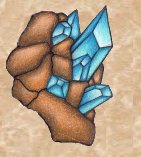INVENTORY
WEAPONS
ITEMS
CONSUMABLES
VEHICLES
CURRENCIES
TECHNOLOGY
HOME
 These are but a few of the unique items produced by the various cultures of Rym. Most are only available through members of the respective cultures, though some will occasionally show up on the open market. Some are magical in nature, while others rely on mechanisms or a combination of the two. The rarest of these are the artifacts left behind by the Creators, distinguishable by their pearl-white casings and golden trim. The item's composition determines its relative durability; an adamas hammerblade is likely to last a lot longer than a hoomiku lodebow made of brass and wood.
These are but a few of the unique items produced by the various cultures of Rym. Most are only available through members of the respective cultures, though some will occasionally show up on the open market. Some are magical in nature, while others rely on mechanisms or a combination of the two. The rarest of these are the artifacts left behind by the Creators, distinguishable by their pearl-white casings and golden trim. The item's composition determines its relative durability; an adamas hammerblade is likely to last a lot longer than a hoomiku lodebow made of brass and wood.
Standard Metals: Materials such as iron and steel are common in everyday life, generally used for tools, weapons, and armor. Weaker, but more stable metals such as gold, silver, and brass, are commonly used in delicate instruments and magical items. Rarer still is platinum, which is derived from the interior mechanisms of Machines, and used extensively in jewelery. Most of these so-called common metals can be purchased on the open market, typically in the form of ingots. A joint pact between the Arcanar guild and the gorg merchant costers of Tamara keep most mining and production strictly in the hands of the empire.
Adamas: Meaning indestructable. This was the dense black alloy created by the City Mind, a metal both immune to magic and far harder than any conventional steel. Adamas also resists the ravages of time, and is not subject to rust or other forms of oxidization. Although heavier than steel, it is highly prized for its robust qualities, and the fact that there is only a limited supply. Machines are composed of adamas, though generally not of a high enough grade to make them magic-immune (Nigh is an exception). Furthermore, true adamas requires incredible heat to shape, far beyond the reach of any conventional forge. Only the skoles and the Arcanar guild are capable of working this metal. Some Tamaran coins are made of adamas.
Clocksteel: This is an alloy of adamas perfected by the cepn, who call it 'clocksteel', and the skoles, who call it 'archsteel'. It can be worked at lower temperatures than true adamas, yet retains much of its parent's durability. Even more impressive is its flexibility, making it ideal for fine cepn clockwork, traps, and poison needles. The alloy is easily identified by its dull blue-violet finish and strangely atonal metallic ring. A clocksteel weapon will keep its edge twice as long as a steel equivalent, and is only slightly heavier. The alloy is also somewhat more resistant to rust than most iron-bearing alloys.
Starpelt: Rym's orbital path is constantly bombarded by light space debris being pulled towards the Eater.Much of this debris ends up crashing into the heavier, slower-moving objects, such as Rym. Many of these meteor storms leave behind great craters and occasionally lumps of pale irridescent metal. Known as 'starpelt' or 'starsilver', it is a fantastic, durable substance, with a clear, musical ring when struck. Though somewhat more brittle than steel, starpelt does not corrode and holds an edge virtually forever. It is commonly used in masterwork tools and instruments, some skolish weaponry, and delicate ornamental jewelery. It does not mix well with other metals.
Ceramics: The Creators oftem made use of light, durable polymers in place of metal, as polymers were virtually immune to aging, and could be manufactured far more easily than adamas. Although not nearly as hard as the black metal, polymers are far lighter and more versatile. The most common type, Z1, is a slick, opalescent white substance used in personel armor, weapon casings, and hardware. Most Machine bodies are cased in pristine white Z1, though the fires of war have burned most Machines to black.
Back...
 These are but a few of the unique items produced by the various cultures of Rym. Most are only available through members of the respective cultures, though some will occasionally show up on the open market. Some are magical in nature, while others rely on mechanisms or a combination of the two. The rarest of these are the artifacts left behind by the Creators, distinguishable by their pearl-white casings and golden trim. The item's composition determines its relative durability; an adamas hammerblade is likely to last a lot longer than a hoomiku lodebow made of brass and wood.
These are but a few of the unique items produced by the various cultures of Rym. Most are only available through members of the respective cultures, though some will occasionally show up on the open market. Some are magical in nature, while others rely on mechanisms or a combination of the two. The rarest of these are the artifacts left behind by the Creators, distinguishable by their pearl-white casings and golden trim. The item's composition determines its relative durability; an adamas hammerblade is likely to last a lot longer than a hoomiku lodebow made of brass and wood.